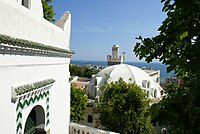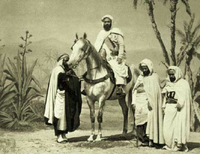Zawiyet Sidi Amar Cherif
- View a machine-translated version of the Arabic article.
- Machine translation, like DeepL or Google Translate, is a useful starting point for translations, but translators must revise errors as necessary and confirm that the translation is accurate, rather than simply copy-pasting machine-translated text into the English Wikipedia.
- Do not translate text that appears unreliable or low-quality. If possible, verify the text with references provided in the foreign-language article.
- You must provide copyright attribution in the edit summary accompanying your translation by providing an interlanguage link to the source of your translation. A model attribution edit summary is
Content in this edit is translated from the existing Arabic Wikipedia article at [[:ar:زاوية سيدي داود]]; see its history for attribution. - You may also add the template
{{Translated|ar|زاوية سيدي داود}}to the talk page. - For more guidance, see Wikipedia:Translation.
Zawiyet Sidi Amar Cherif (Arabic: زاوية سيدي أعمر الشريف), or Zawiyet Sidi Daoud, is a zawiya school located in Boumerdès Province in Algeria.[1]
Construction
The zawiya was built in 1745 in the eastern heights of the current town of Boumerdès in the Kabylia region.[2][3] It was founded by scholar Sidi Amar Cherif.[4][5]
Missions
The zawiya is considered a prominent religious teacher for teaching the Quran and its basic rulings to young people. It also provides the various mosques of Boumerdes Province during the month of Ramadan every year with a preservation that leads to Tarawih prayers by reciting the Quran with the Warsh recitation.[6][7][8][clarification needed]
This zawiya has had dozens of male and female Hafiz graduates.[9][10][11]
It is a place to study and teach the Quran, as well as providing aid to the needy and those about to get married and organizing circumcision ceremonies.[12][13][14]
It is one of the Zawiyas in Algeria that plays an important role in social life in the Sidi Daoud region. It is considered a modernized school, as it is based on the traditional and modern way of teaching the Quran and Sunnah as well.[15][16][17]
French conquest

When the French landed in Algiers during 1830 and the period of Ottoman Algeria gave way to an African state dislocated and invaded by colonial troops of the invading French Army, the zawiya of Sahel Bouberak could no longer be satisfied with their level of education in Sufism.[18][19] Therefore, Cheikh Cherifi soon allied with Cheikh Ben Zamoum to counter the advance of French colonial appetites towards Kabylia and the valleys of Oued Isser and Oued Sebaou until 1837.[20][21]
The turn of military events in Mitidja ended in 1837 with a recurrence of conflict. The Emirate of Abdelkader, represented by his younger brother Emir Mustapha (Bey in Beylik of Titteri), with murids of the zawiyas of Lower Kabylia, organized a surprise attack on 8 May 1837 on a large agricultural farm in Reghaia managed by the two colonists Mercier and Saussine.[22][23]
This zawiya, affiliated with the Rahmaniyya brotherhood, played a crucial role (along with the Sheikhs of Zawiyet Sidi Boushaki and Zawiyet Sidi Boumerdassi) in triggering the Kabyle response against colonial expansion east of the Casbah of Algiers.[24][25]
The looting and sacking of the farm bordering the Khachna Massif could not leave the belligerents in a situation of calm and ceasefire. Therefore, General Damrémont took advantage of this Algerian attack to raise the military forces stationed in Algiers under the direction of General Perregaux and Colonel Schauenburg to organize a punitive expedition against the Kabyles of the tribes of Beni Aïcha, Issers and Amraoua among the Iflissen Lebhar.[26]
The Zawiyet Sidi Amar Cherif participated in unveiling the lure of peace with the French colonizers, who rushed at this opportunity to try to attack the Kabyles, starting 17 May 1837, which ended in failure on the bank of Oued Isser due to bad weather and ignorance of the escarpment of the hills of the Col des Beni Aïcha.[27]
Cheikh Cherifi, Cheikh Ben Zamoum and Cheikh Boushaki took advantage of the defeat of the French soldiers to pursue them to their camp in Boudouaou on 25 May, but reinforcements arriving from Algiers ended up overturning the First Battle of Boudouaou in favor of the French, commanded by Captain Antoine de La Torré on 30 May.[28]
The zawiya of Sidi Daoud entered fully into the resistance against the French conquest of Algeria and continued until the independence of Algeria in 1962.[29]
Notable people
- Sidi Amar Cherif [ar]
- Cheikh Mohamed Cherifi
- Mohamed Seghir Boushaki (1869–1959)
- Ali Boushaki (1855–1965)
- Abderrahmane Boushaki (1896-1985)
- Brahim Boushaki (1912–1997)
- Mehdi Boualem
- Ahmed Mebtouche
- Abdelkader Hammami
- Abdelkader Hasbellaoui
- Mohamed Hamek
- Cheikh Meddahi
- Cheikh Kezadri
See also
Bibliography
- Ferdynand Antoni Ossendowski (1800). Sous le fouet du Simoun. Paris: Ernest Flammarion, Éditeur. p. 193.
- Antoine-Ernest-Hippolyte Carette (1848). Exploration scientifique de l'Algérie pendant les années 1840, 1841, 1842. Paris: Imprimerie Royale. p. 192.
- Société historique algérienne (1871). Revue africaine, Volume 46. Algiers: Adolphe Jourdan, Libraire-Éditeur. p. 51.
- Société historique algérienne (1876). Revue africaine, Volume 115. Algiers: Adolphe Jourdan, Libraire-Éditeur. p. 208.
- Bulletin, Volume 22. Algiers: Société de géographie d'Alger et de l'Afrique du Nord. 1921. pp. 51–53.
- Cahiers nord-africains, Numéros 14 à 28. Paris: Études sociales nord-africaines. 1951. p. 27.
- Pierre Muraour (1956). Contribution à l'étude stratigraphique & sédimentologique de la Basse-Kabylie. Algiers: Service de la carte géologique de l'Algérie. pp. 80, 119.
- Bulletin - Service de la carte géologique de l'Algérie. Algiers: Service de la carte géologique de l'Algérie. 1956. pp. 80, 117, 120.
- Charles André Julien, Charles Robert Ageron (1964). Histoire de l'Algérie contemporaine. Paris: Presses universitaires de France. p. 286.
- Revue de L'Occident Musulman Et de la Méditerranée, Numéros 1 à 4. Algiers: Association pour l'étude des sciences humaines en Afrique du Nord. 1966. p. 24.
- Charles Robert Ageron (1972). Politiques coloniales au Maghreb. Paris: Presses universitaires de France. p. 264.
- Charles André Julien (1979). Histoire de l'Algére contemporaine, Volume 2. Paris: Presses universitaires de France. p. 286. ISBN 9782130356448.
- Rabah Saadallah (1981). El-Hadj M'hamed El-Anka: maître et renovateur de la musique "chaabi". Algiers: La Maison des Livres. p. 72.
- Littérature orale arabo-berbère, Numéros 13 à 15. Algiers: Ecole des hautes en sciences sociales. 1982. p. 66.
- Ahmed Hannache (1990). La longue marche de l'Algérie combattante (1830-1962). Algiers: Éditions Dahlab. p. 294.
- Mohamed Seghir Feredj (1999). Histoire de Tizi-Ouzou et de sa région: des origines à 1954. Algiers: Éditions Hammouda. pp. 70, 85, 107. ISBN 9789961890004.
- Kamel Chachoua (2000). Zwawa et zawaya. Paris: Ecole des Hautes Etudes en Sciences Sociales. p. 366.
- Mohamed Salhi (2006). Société et religion en Kabylie: 1850-2000, Volume 2. Algiers: Atelier national de reproduction des thèses. p. 792. ISBN 9782729563080.
- Jacques Bouveresse (2010). Un parlement colonial ? Les Délégations financières algériennes 1898-1945: Tome 2. Paris: Publications des universités de Rouen et du Havre. p. 481. ISBN 9782877754972.
References
- ^ "Revue africaine". 1971.
- ^ "عيسى بلخضر يتعهد بمواصلة خدمة الزوايا". جزايرس.
- ^ "الزاوية المجاهدة". جزايرس.
- ^ "الزاوية المجاهدة". الشروق أونلاين. October 21, 2019.
- ^ "Mémoire nationale : l'Etat a une vision "claire et à long terme" au sujet des zaouias". Djazairess.
- ^ Saadallah, Rabah (1981). "El-Hadj M'hamed El-Anka: Maître et renovateur de la musique "chaabi"".
- ^ "العلامة الجليل ذي النسب الشريف". جزايرس.
- ^ "Sidi-Daoud, une ville à l'abandon". Djazairess.
- ^ Salhi, Mohamed (2006). Société et religion en Kabylie: 1850-2000. ISBN 9782729563080.
- ^ "أشرف على تدشين عديد المرافق التربوية والرياضية". جزايرس.
- ^ "Sidi-Daoud, l'ancienne Abbo !". Djazairess.
- ^ "Revue de l'Occident Musulman et de la Méditerranée". 1966.
- ^ Feredj, Mohamed Seghir (1999). Histoire de Tizi-Ouzou et de sa région: Des origines à 1954. ISBN 9789961890004.
- ^ "يومية الشعب الجزائرية - العـلامـــة الجليــل ذي النسب الشـريف". www.ech-chaab.com. Retrieved Feb 25, 2021.
- ^ "Littérature orale arabo-berbère". 1982.
- ^ "تسوية وضعية 100 وقف ومساع لإحياء دور الزوايا". جزايرس.
- ^ Julien, Charles André (1979). Histoire de l'Algére contemporaine. ISBN 9782130356448.
- ^ Ossendowski, Ferdynand Antoni (1800). "Sous le fouet du Simoun".
- ^ "Cahiers nord-africains". 1951.
- ^ Carette, Antoine-Ernest-Hippolyte (1848). "Exploration scientifique de l'Algérie pendant les années 1840, 1841, 1842".
- ^ "Bulletin". 1921.
- ^ Algérienne, Société Historique (1875). "Revue africaine".
- ^ Bouveresse, Jacques (2010). Un parlement colonial ? Les Délégations financières algériennes 1898-1945: Tome 2, le déséquilibre des réalisations. Publications des universités de Rouen et du Havre. ISBN 9782877754972.
- ^ Chachoua, Kamel (2000). "Zwawa et zawaya: l'Islam "la question kabyle" : Et l'État en Algérie. Autour de la Rissala, épître, "Les plus clairs arguments qui nécessitent la réforme des zawaya kabyles", d'Ibnou Zakri (1853-1914), clerc officiel dans l'Algérie coloniale, publiée à Alger, aux Editions Fontana en 1903".
- ^ Plantade, Nedjima (1988). La guerre des femmes: Magie et amour en Algérie. La Boîte à Documents. ISBN 9781906164034.
- ^ "Revue africaine0". 1876.
- ^ Hannache, Ahmed (1990). "La longue marche de l'Algérie combattante (1830-1962)".
- ^ Julien, Charles André; Ageron, Charles Robert (1964). Histoire de l'Algérie contemporaine: Ageron, C.R. De l'insurrection de 1871 au déclenchement de la guerre de libération (1954). ISBN 9782130356448.
- ^ "Bulletin - Service de la carte géologique de l'Algérie". 1956.
External links
- Zawiyet Sidi Amar Cherif on Facebook
- Ceremony in the Zawiya of Sidi Amar Cherif during 2017 on YouTube
- Ceremony in the Zawiya of Sidi Amar Cherif during 2019 on YouTube
- v
- t
- e
- Zawiya Thaalibia(Algiers)
- Zawiya Thaalibia(Issers)
- Zawiyet Sidi Amar Cherif(Sidi Daoud)
- Zawiyet Sidi Boumerdassi(Tidjelabine)
- Zawiyet Sidi Boushaki(Thenia)
- Zawiyet Sidi M'hamed Bou Qobrine [ar](Algiers)
- Zawiyet Sidi M'hamed Bou Qobrine [ar](Bounouh)
- Zawiyet Sidi Saadi [ar](Algiers)
- Zawiyet Sidi Amar [fr](Algiers)
- Zawiya Belkaïdia [fr](Algiers)
- Zawiya Belkaïdia [ar](Oran)
- Zawiyet El Hamel [ar](El Hamel)
- Zawiyet Sidi M'Hamed Saadi [ar](Aafir)
- Zawiyet Sidi Ali Debbaghi [ar](Beni Amrane)
- Zawiyet Sidi Ghobrini [ar](Khemis El-Khechna)
- Zawiyet Sidi Salem [ar](Boudouaou)

- Alawiyya [ar]
- Chabiyya
- Darqawiyya
- Dardouriyya
- Habibiyya
- Hansaliyya [ar]
- Isawiyya
- Karzaziyya [ar]
- Khalwatiyya
- Madyaniyya
- Omariyya
- Ouazzaniyya
- Naciriyya
- Qadiriyya
- Rahmaniyya
- Senusiyya
- Shadhiliyya
- Sheikhiyya
- Taïbiyya
- Tijaniyya
- Youssoufiyya
- Zaïaniyya
- Zarrouqiyya

















